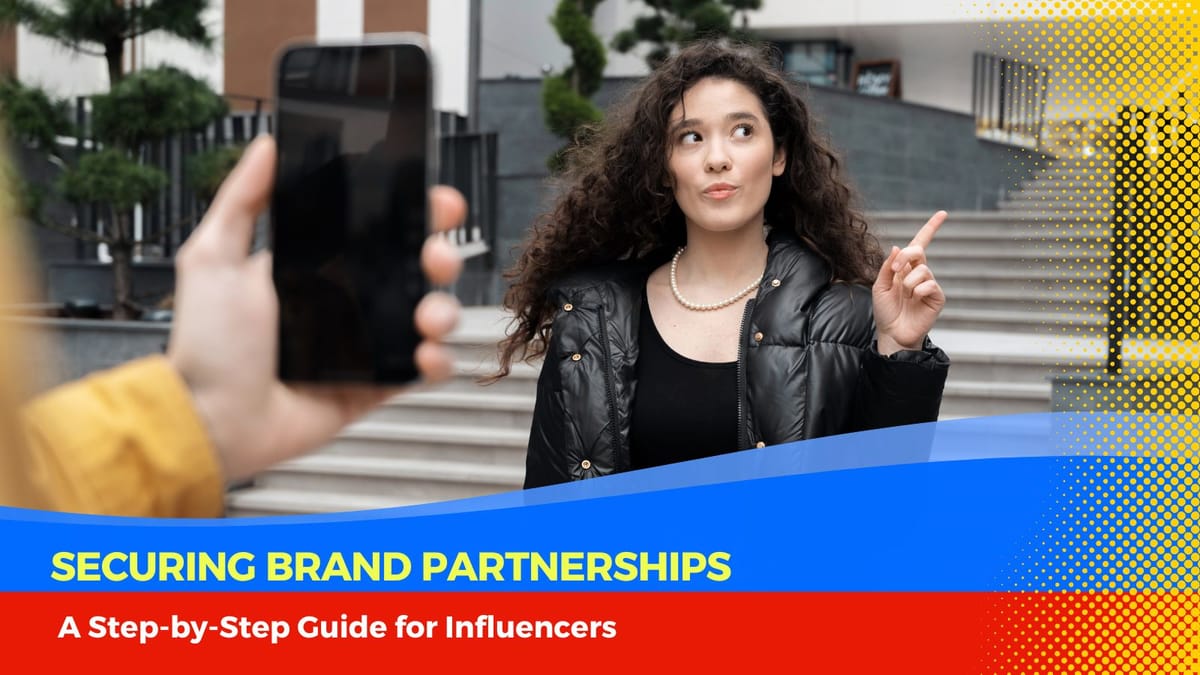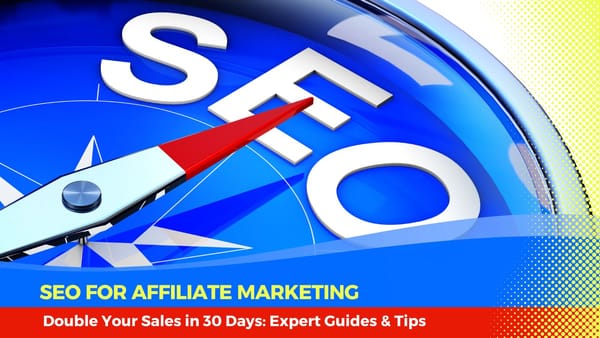Securing Brand Partnerships: A Step-by-Step Guide for Influencers

You've worked hard to build your audience and create engaging content. Now, it's time to take it to the next level: securing lucrative brand partnerships. For influencers, affiliate marketers, and premium publishers, brand collaborations are more than just a revenue stream; they're a way to enhance credibility and expand reach. In this guide, we'll help you understand brand partnerships and give you the tools to secure and maximise them.
1. Understanding Brand Partnerships
1.1 What are Brand Partnerships?
Brand partnerships involve collaboration between influencers and brands, where both parties work towards mutual benefits. As an influencer, you promote a brand's products or services to your audience, often through social media posts, videos, or blog articles. The goal is to create authentic endorsements that resonate with your followers, driving engagement and conversions.
These agreements can vary widely. You might engage in a one-off sponsored post, or a long-term ambassador programme. Sometimes, brand partnerships are built around creation and co-branding of products, adding a personalised touch to the collaboration. Understanding these variations helps you choose the best type that aligns with your personal brand and audience.
Pro-tip: Keep an eye on your metrics. Platforms like Bloomclicks offer real-time reporting and statistics, allowing you to assess the effectiveness of your brand partnerships promptly.
1.2 Why are They Important for Influencers?
Brand partnerships are crucial for influencers, especially in monetizing their platforms. Collaborations with reputable brands add credibility and can significantly boost your earning potential. Brands often allocate substantial budgets to influencer marketing, recognising it as a powerful tool for reaching diverse and engaged audiences.
For affiliate marketers and premium publishers, having a roster of reliable brands elevates your portfolio and expands your revenue streams. This is particularly vital in verticals such as health, beauty, and tech, where high-quality partnerships can lead to significant income through commissions or direct payments.
Pro-tip: Build a varied portfolio. Engaging with multiple brands from different industries not only diversifies your income but also broadens your audience base.
1.3 Types of Brand Partnerships
There are several types of brand partnerships, each with its own unique characteristics. Sponsored posts are one of the most common types, where you create content promoting a product or service for a fee. Affiliate marketing involves promoting a brand’s products and earning a commission on sales made through your referral links.
Other formats include brand ambassadorships, where you represent a brand over a longer period of time and develop a deeper relationship. Product seeding involves receiving free products in exchange for reviews or content creation. These types of partnerships help both new and established influencers showcase products authentically.
Pro-tip: Tailor your approach. Different brands respond to different types of partnerships, so adapt your strategy based on what you believe will be most effective for your audience.
By understanding the importance and types of brand partnerships, you're better equipped to identify which opportunities align best with your personal brand and audience. This foundational knowledge sets the stage for identifying potential partners and crafting compelling pitches.
2. How to Identify Potential Brand Partners
2.1 Researching Brands that Align with Your Audience
Identifying potential brand partners starts with understanding your audience. Look for brands that naturally align with your followers' interests and demographics. You can do this by analysing your audience’s data from social media insights or Google Analytics. What products do they engage with the most? What are their top interests? Once you have this information, create a list of brands that fit these criteria.
To streamline your research:
- Conduct surveys or polls on your platforms to gather more specific interests.
- Explore hashtags and trends within your niche to discover popular and emerging brands.
- Leverage social listening tools like Hootsuite or Brandwatch to see which brands your followers mention and interact with frequently.
Pro-tip: Regularly update your audience analysis to reflect any shifts in interests and demographics.
2.2 Assessing a Brand’s Reputation and Values
After identifying potential brands, it’s crucial to assess their reputation and values. Start by doing a simple Google search to see if there are any negative news articles or reviews about the brand. Go through their social media profiles to understand how they interact with customers and handle complaints. Additionally, check platforms like Trustpilot or the Better Business Bureau for more detailed reviews.
Consider these points when assessing a brand:
- Transparency: Does the brand clearly state its values and mission on their website or social media?
- Responsiveness: How quickly do they respond to customer queries or complaints online?
- Consistency: Are their marketing messages consistent across different platforms?
Pro-tip: Reaching out to other influencers or partners who have worked with the brand can provide valuable first-hand insights.
2.3 Tools and Platforms for Finding Brand Partnerships
Finding potential brand partners can be more manageable with the right tools and platforms. Websites like Bloomclicks offer a comprehensive database of top global brands and exclusive campaigns, making it a valuable resource for affiliate marketers, influencers, and premium publishers. Browsing through such platforms can save time and effort in locating suitable partnerships.
Some useful tools and platforms include:
- Influencer networks like AspireIQ or Influencity connect influencers with brands looking for collaborations.
- Social media platforms like Instagram and Twitter can also be great for spotting brand opportunities. Follow brand profiles and keep an eye on sponsored content by other influencers.
- Influencer marketing platforms like Bloomclicks, where you can gain access to exclusive campaigns and top-performing brands.
Pro-tip: Consistently engaging with these tools and platforms will keep you updated on new partnership opportunities and trends.
3. Crafting Your Pitch
3.1 Elements of a Successful Pitch
Knowing how to craft a successful pitch is crucial to winning brand partnerships. The first element you need is a clear and concise introduction about who you are and what you do. Describe your niche, your audience demographics, and why these make you a valuable partner. Be specific about your follower count, engagement rates and the type of content you produce. For example, if you're an influencer known for your travel vlogs, state that and back it up with your most popular posts and their performance metrics.
Next, outline your proposal clearly. Explain what you offer—whether it’s a dedicated blog post, social media shoutouts, or a full-blown marketing campaign. Make sure to detail how you plan to integrate the brand into your content naturally. Use bullet points to list deliverables like posts, stories, or videos. Explain how these elements can provide value to the brand, such as increasing brand awareness or boosting sales.
Pro-tip: Always back your pitch with data. Include case studies or examples of past successful collaborations to build credibility.
3.2 Tailoring Your Pitch for Different Brands
Every brand has its own unique mission and audience, so tailoring your pitch to different brands is essential. Start by researching the brand's current campaigns, product lines, and typical customer base. Tailor your proposal to show how you can help them reach their goals. For instance, if you're pitching to a brand focusing on sustainable products, emphasise your content on eco-friendly living and how your audience values sustainability.
Include specific language and themes reflective of the brand’s voice and messaging. If a brand highlights 'wellness and self-care,' ensure your pitch echoes these values. Aligning with the brand's ethos helps demonstrate that you're not just pitching blindly but are genuinely interested in a mutual partnership.
3.3 When and How to Follow Up
Following up is a critical part of any pitching process. Send a follow-up email within a week if you haven't received a response. The follow-up should be polite and reiterate your interest. Keep it brief—highlight the key points from your initial pitch and express your eagerness to collaborate.
If the brand responds but is uncertain, ask for a meeting to discuss the partnership further. Suggested formats include a brief call or a video chat to dig into the details. This follow-up step often highlights your persistence and genuine interest, increasing your chances of landing the partnership.
Pro-tip: Use a CRM tool to track your follow-up efforts and keep a timeline of your communications.
4. Negotiating Partnership Terms
4.1 Understanding the Basics of Negotiation
In the realm of brand partnerships, being able to negotiate effectively is crucial. Preparation is the first step. Understand your own value and what you bring to the table. Know the brand's goals, target audience, and how your influence can help them achieve those goals. Research is key to understanding these dynamics. Know the standard industry rates for services similar to what you're offering — this knowledge makes you more confident and credible during negotiations.
When negotiating, effective communication is vital. Be clear and concise about your expectations and what you're offering. Listen to the brand's needs and try to find common ground. Use assertive language that shows you value your work, but also remain open to compromise. The aim is to create a win-win situation where both parties feel they benefit from the partnership.
Pro-tip: Practice active listening — it can reveal a lot about the brand's priorities and help you tailor your proposal accordingly.
4.2 Discussing Compensation and Deliverables
Discussing compensation can be daunting, but it's essential to be upfront about it. Different compensation models include flat fees, commission-based payments, product exchanges, or a hybrid approach. Clearly state your preferred model based on the deliverables you will provide. For example, a flat fee might be suitable for a one-off Instagram post, while commission might be better for ongoing affiliate marketing efforts.
When it comes to deliverables, clarity is key. Detail what you will offer, whether it’s social media posts, blog content, or participation in events. Be specific about deadlines, the number of posts, or any other metrics that will define the scope of work. Ensure the deliverables align with the brand’s campaign goals and your own capabilities. This helps prevent misunderstandings and sets clear expectations.
Pro-tip: Always document the agreed terms in written form, such as emails or contracts, to avoid any disputes later on.
4.3 Protecting Your Rights and Finalizing Agreements
Protecting your rights is as important as securing the partnership. Ensure that you have a clear contract outlining all agreement terms, including compensation, deliverables, deadlines, and ownership of content. A contract safeguards both parties and serves as a legal reference in case any disputes arise. Consulting with a legal professional can help if you're unsure about any terms in the contract.
Finally, make sure to thoroughly review the contract before signing. Look out for any clauses related to exclusivity, as this may restrict you from working with other brands. Ensure there are provisions for content approval and usage rights, so you have control over how your content is used. Be cautious with any non-compete clauses, ensuring they’re fair and don't hinder future opportunities.
Pro-tip: Use a contract management tool like DocuSign to streamline the contract review and signing process, providing both you and the brand with digital copies for record-keeping.
5. Maximizing the Benefits of Brand Partnerships
5.1 Delivering Quality Content and Engaging Your Audience
Delivering quality content is the cornerstone of a successful brand partnership. To consistently produce high-quality posts, it’s vital to understand what your audience loves and expects from you. This could include using high-resolution images, engaging video content, or informative and entertaining blog articles. Always aim for authenticity; be genuine in your promotion and align it with your usual content style.
Pro-tip: Always engage directly with your audience. Respond to comments, thank them for their support, and ask questions to increase interaction. Tools like Instagram Stories, YouTube Live, and Facebook polls can help you get real-time feedback. By making your audience feel valued, you strengthen the bond with them and increase the overall impact of your promoted content.
Effective audience engagement involves more than just producing content; it’s about fostering a community. Build a relationship with your followers by sharing snippets of your life, successes, failures, and the behind-the-scenes work that goes into your creations. This transparency draws your audience closer and makes them more likely to engage and trust your recommendations.
Pro-tip: Leverage user-generated content. Encourage your followers to share their experiences with the brand you are promoting. Reposting their content on your platforms not only builds loyalty but also provides fresh, genuine content that can draw in more potential followers and customers.
5.2 Evaluating and Reporting on Partnership Success
Evaluating the success of your brand partnerships is key to understanding their effectiveness and value. Use metrics such as engagement rates, click-through rates, and conversions to gauge the impact of your campaigns. Tools like Google Analytics, Instagram Insights, or Facebook Insights can help track these metrics. Accurate reporting hinges on setting clear goals before starting the partnership.
Break down your reports into specific areas:
- Engagement Metrics: Likes, shares, and comments.
- Reach Metrics: Views, impressions.
- Conversion Metrics: Sales, sign-ups.
Providing detailed reports to your brand partners shows professionalism and reinforces the value you bring to the table.
Recent studies reveal that 89% of marketers rate ROI from influencers as comparable to or better than other marketing channels (source: Mediakix). This indicates the significance of clearly tracking and reporting your campaign results. Align your reporting format with the brand’s preferences. Some might prefer visual dashboards, while others might want detailed spreadsheets. Customizing your reporting process will make it easier for the brand to understand and appreciate your impact.
Pro-tip: Create a post-campaign survey for your audience to gather direct feedback. Ask about their thoughts on the collaboration and the product/service. This direct input can provide valuable qualitative data that complements your quantitative metrics.
5.3 Building Long-Term Relationships with Brands
Building long-term relationships with brands starts with outstanding professional behaviour and consistent performance. Always deliver what you promise and exceed expectations where possible. Good communication is fundamental; check in regularly with brand representatives, update them on progress, and be open to feedback and revisions.
Actionable steps to foster lasting connections:
- Regular Check-ins: Maintain consistent communication.
- Feedback loops: Be open to the brand’s input.
- Deliverables: Always deliver high-quality content.
Always seek opportunities to add extra value, such as creating bonus content or proposing new ideas for collaboration. Brands value partners who show initiative and creativity.
Proactive engagement with your brand partners strengthens your professional bond. Send thank you notes post-project, celebrate their milestones, and express genuine interest in their journey. Actions like these go a long way towards making you the go-to influencer whenever they have new campaigns.
Pro-tip: Use platforms like Bloomclicks that offer dedicated support and real-time analytics. Tools like these ensure timely payments and robust tracking, making your partnerships smoother and more transparent.
Establishing sustainable, long-term partnerships with brands not only stabilises your income as an influencer but also enhances your credibility. Being repeatedly chosen by a brand signals your reliability and professionalism to other potential partners, leading to further opportunities.
For influencers, affiliate marketers, and premium publishers looking to structure profitable and sustainable brand partnerships, consistent engagement with robust analytics and relationship-building is key. Check out Bloomclicks' attractive commission rates and dedicated support, which can make it simpler and more rewarding.
Frequently Asked Questions
How do I get a brand partnership as an influencer?
To get a brand partnershippartnership,, create a compelling pitch highlighting your value, audience, and previous successful collaborations. Research the brand to ensure alignment of values and approach them via email or social media.
How do influencers connect with brands?
Influencers connect with brands through networking at industry events, using platforms like Bloomclicks, and directly reaching out via email or social media.
How do you structure a brand partnership?
Structured partnerships typically include setting clear goals, defining deliverables, agreeing on compensation, and planning a timeline. Ensure to sign a formal agreement.
How do you approach influencers for collaboration?
To approach influencers, research their audience, reach out with a personalised message, offer clear collaboration benefits, and propose specific ideas for partnership.





